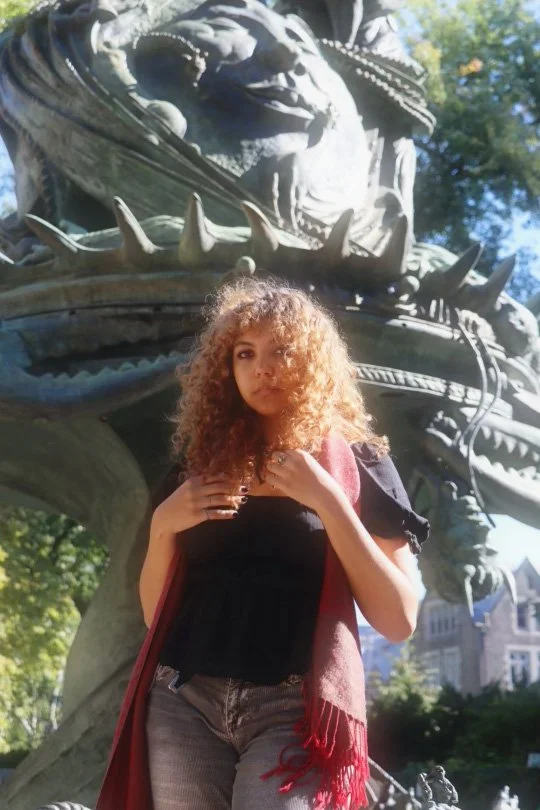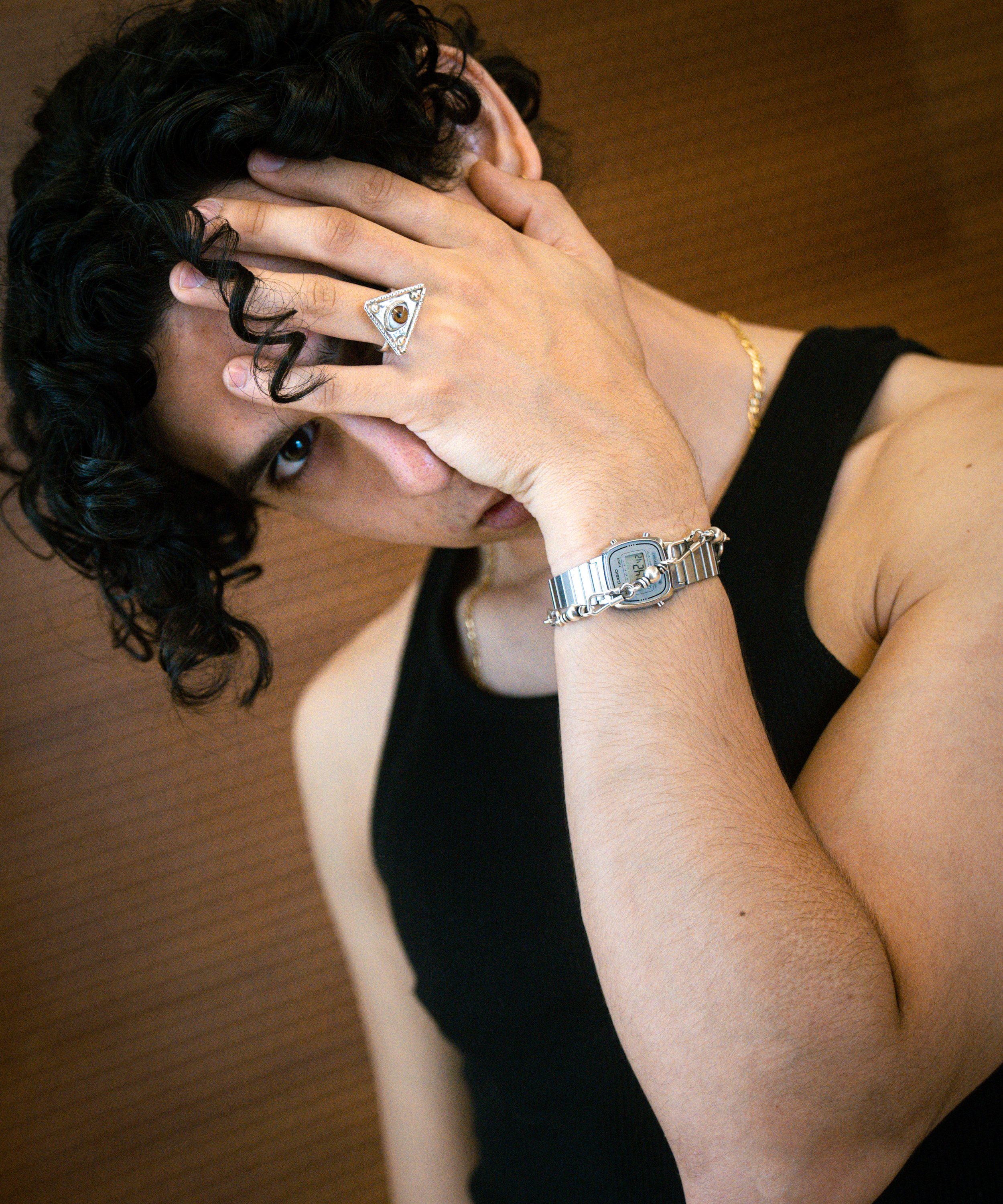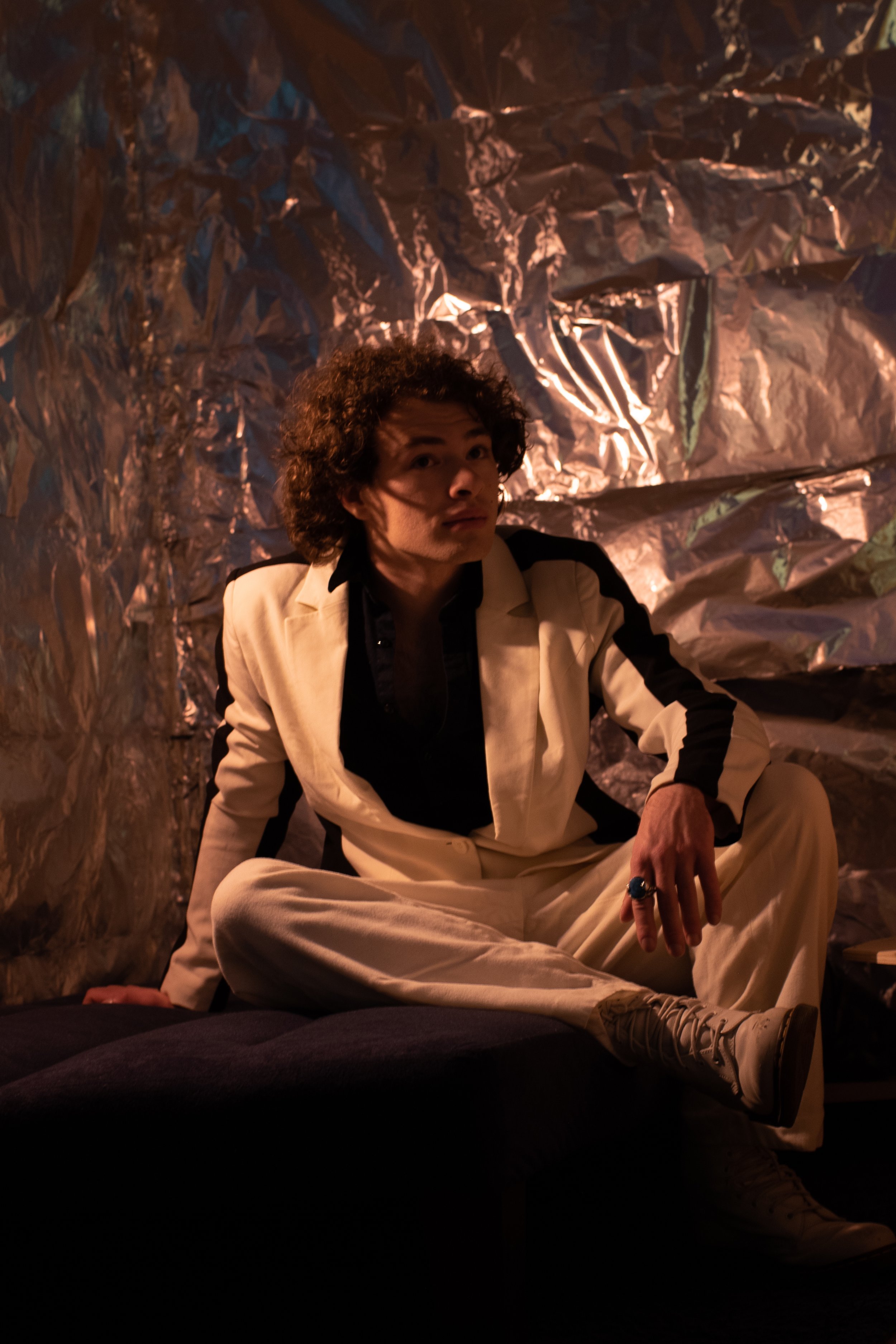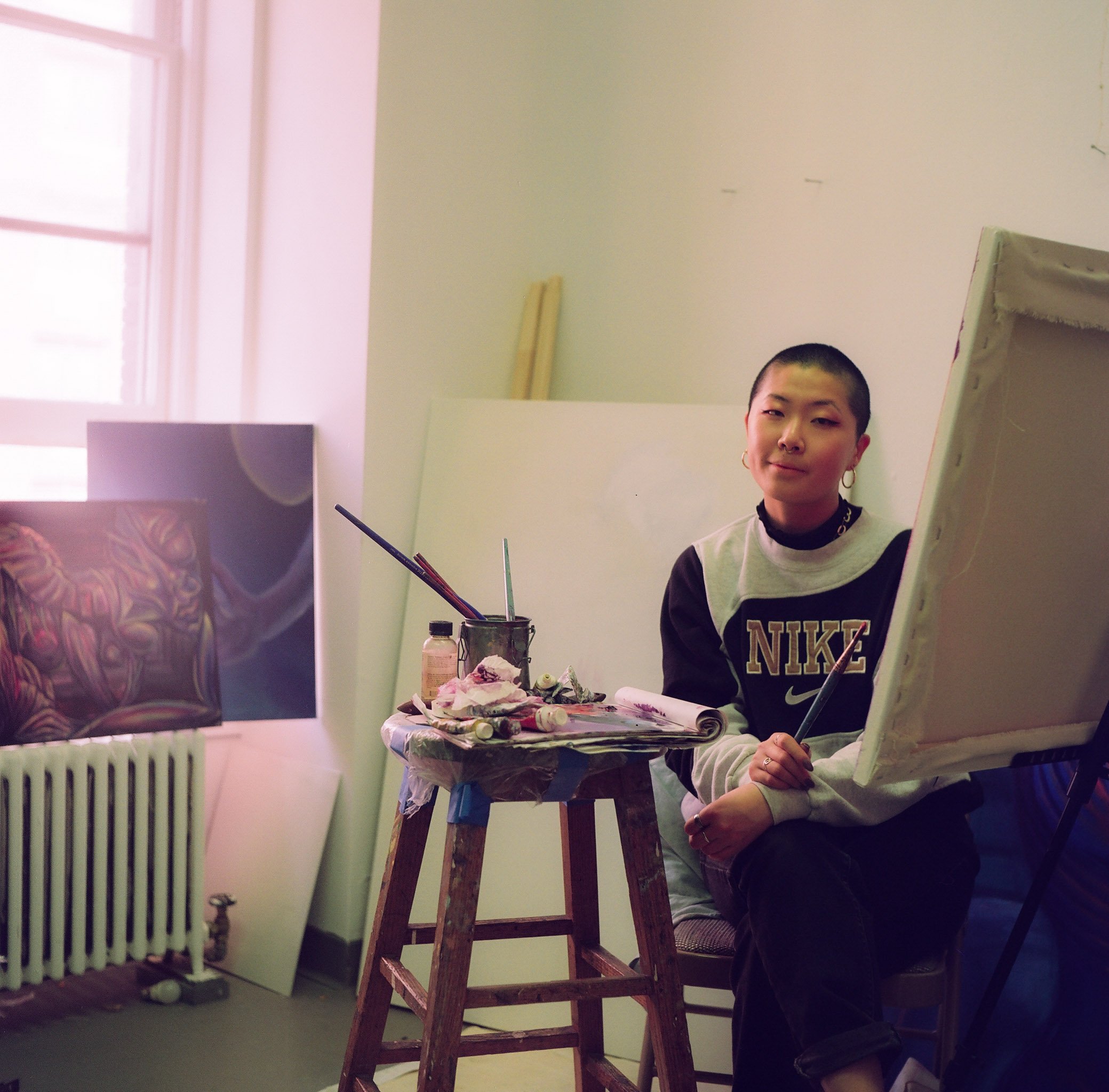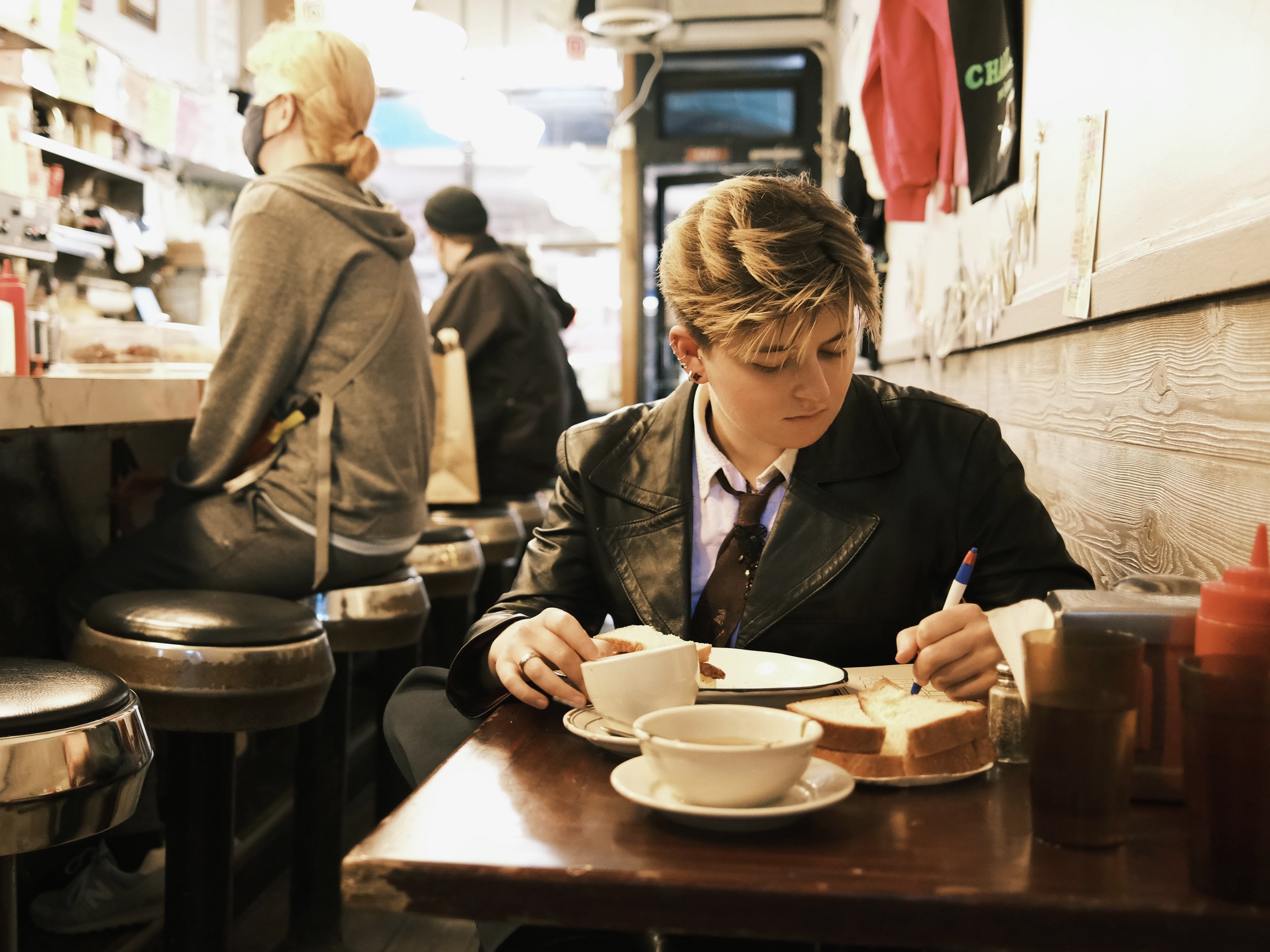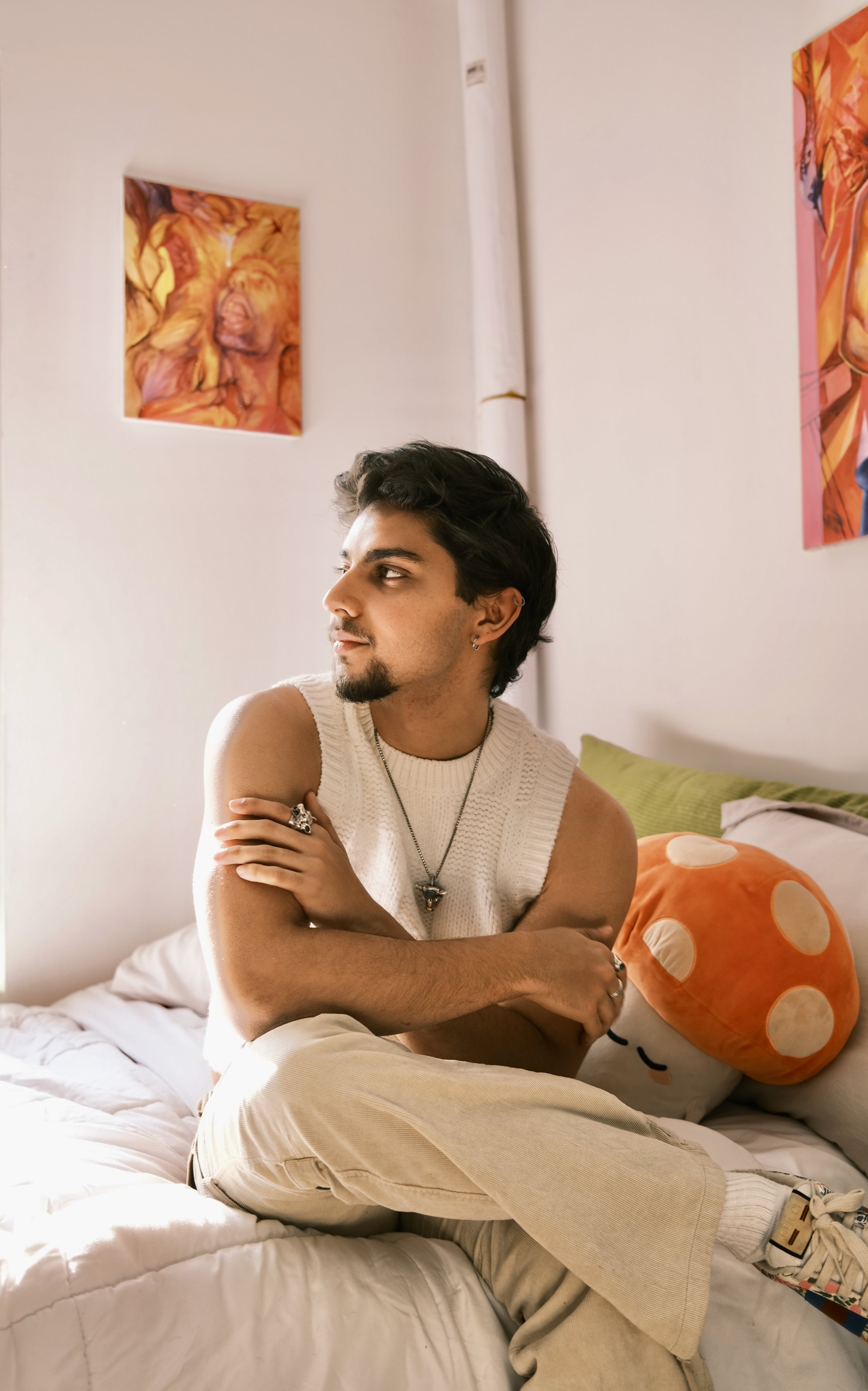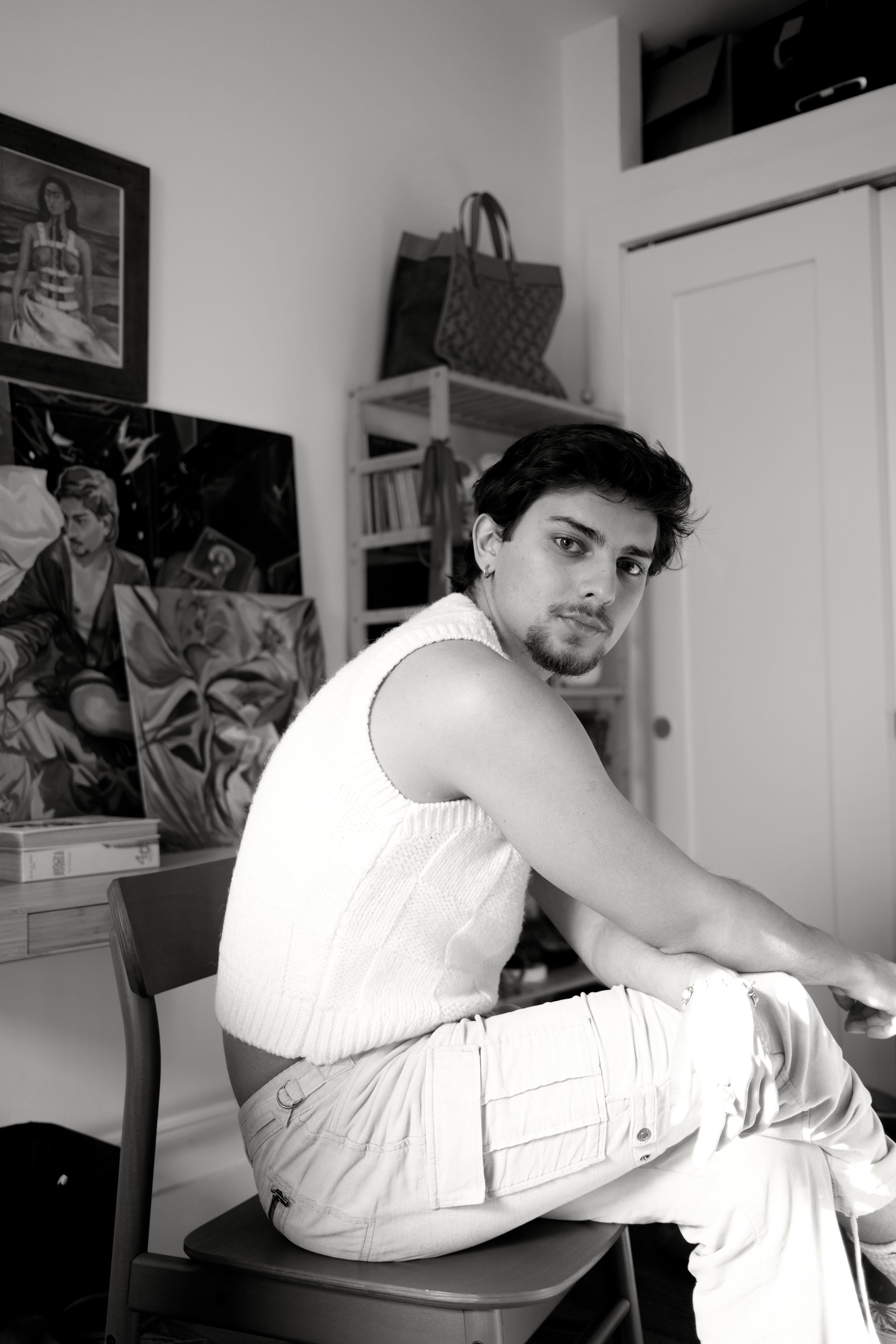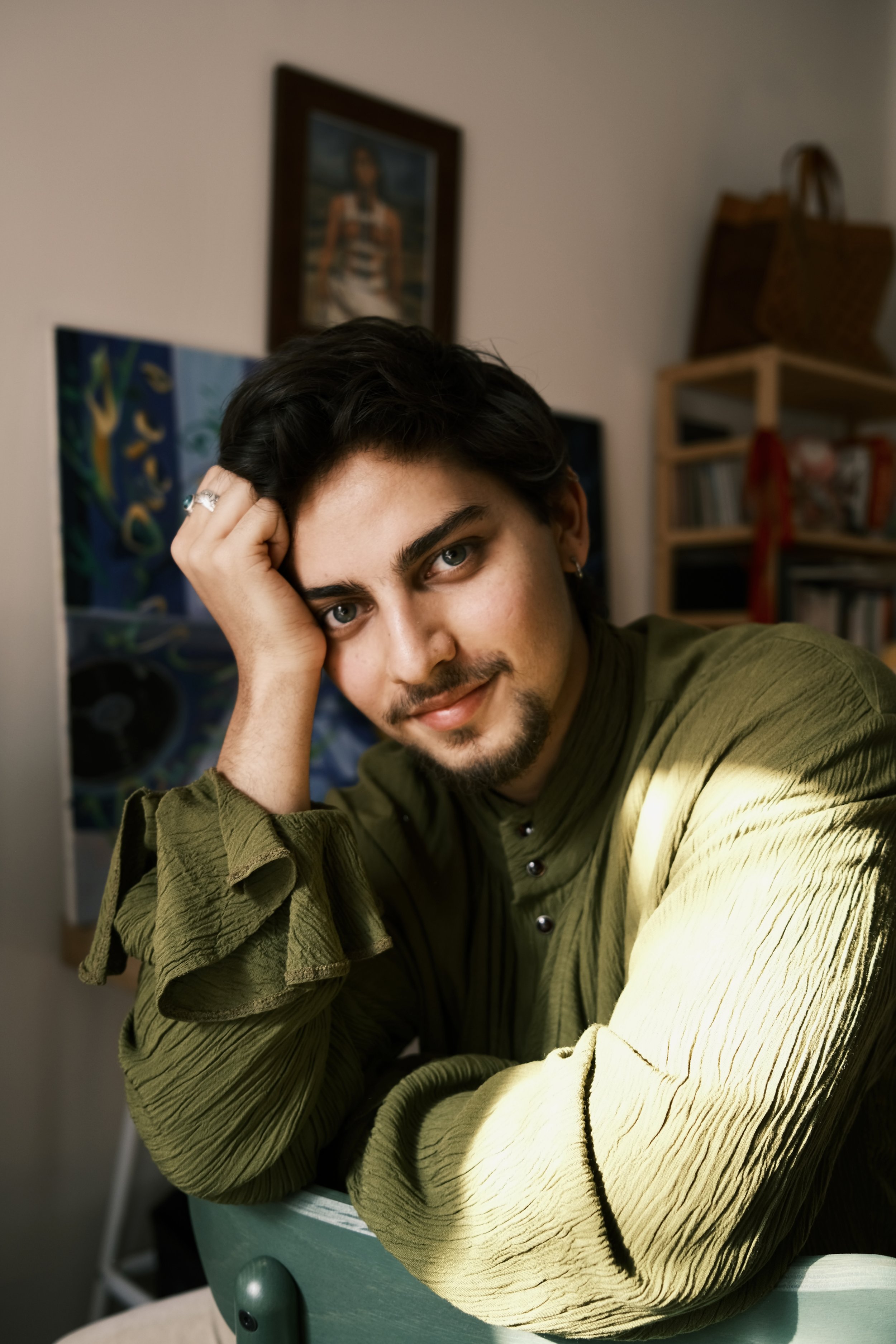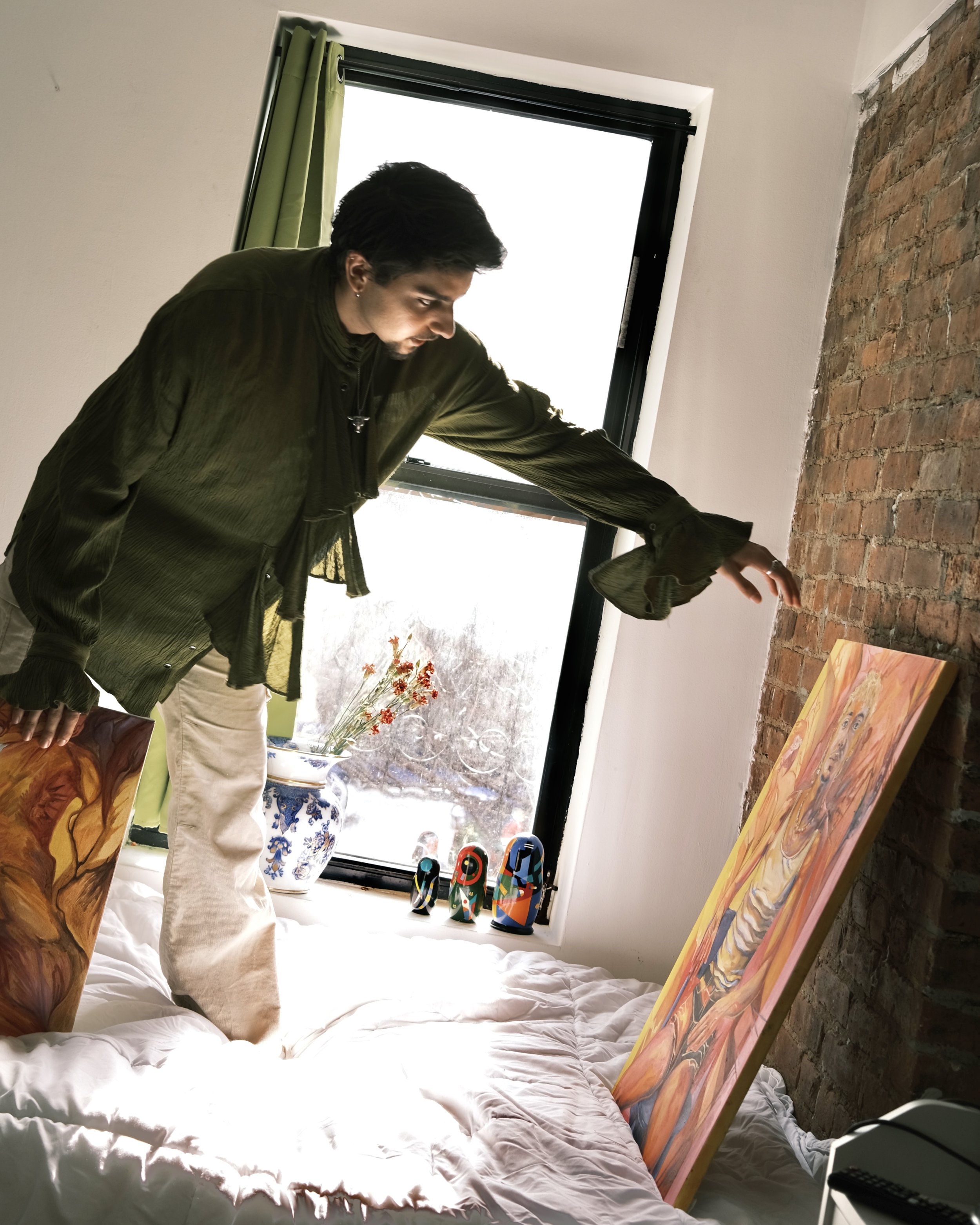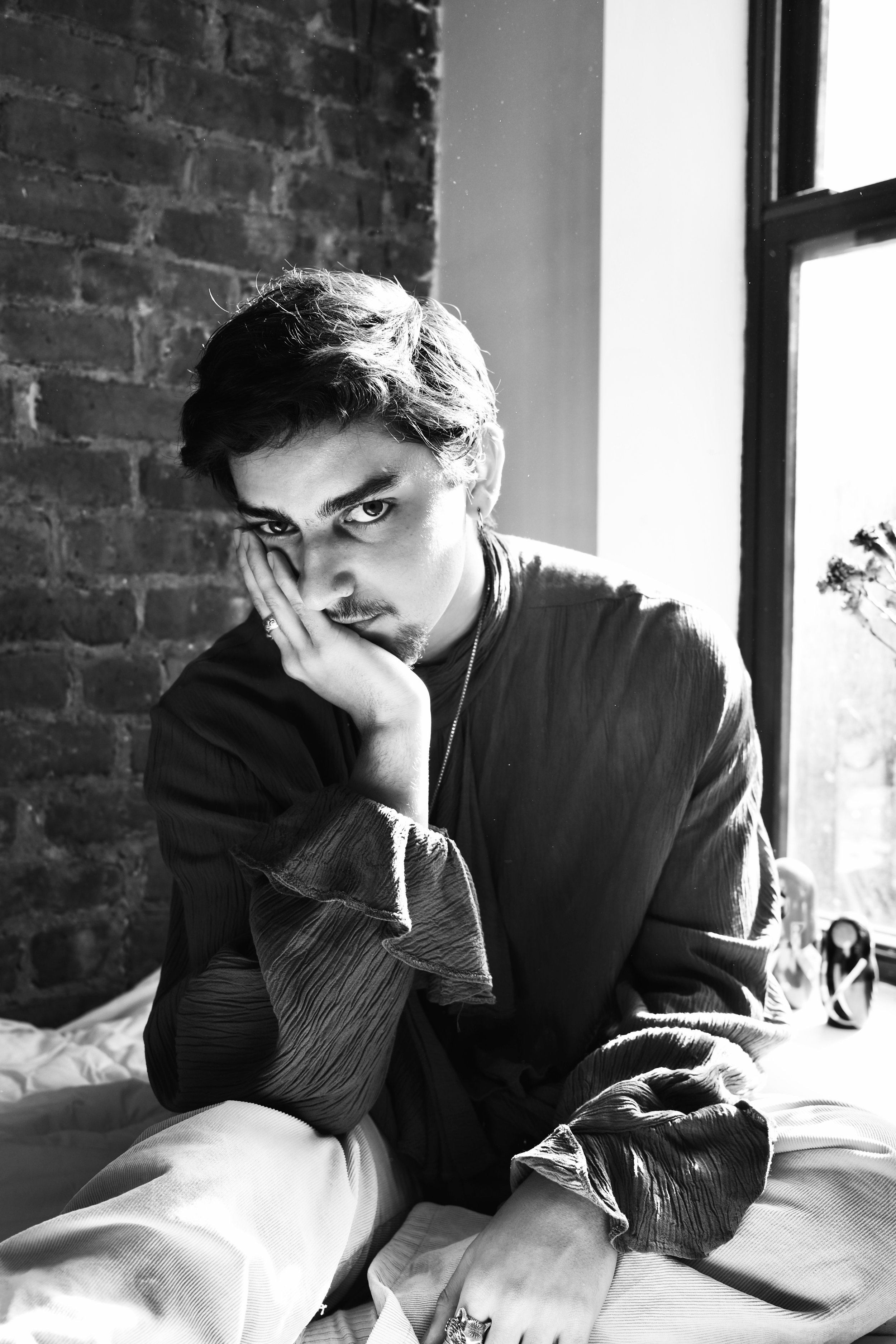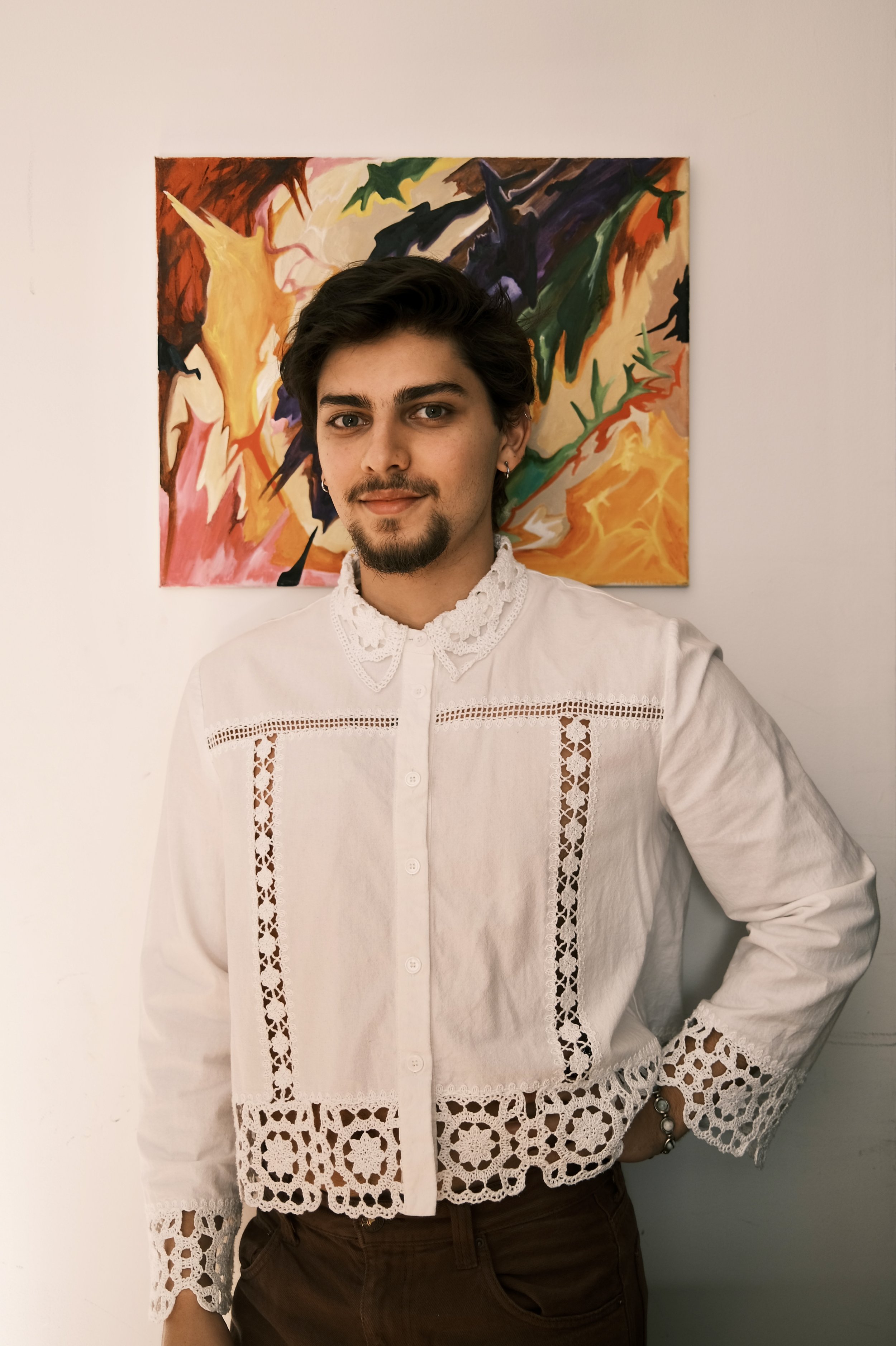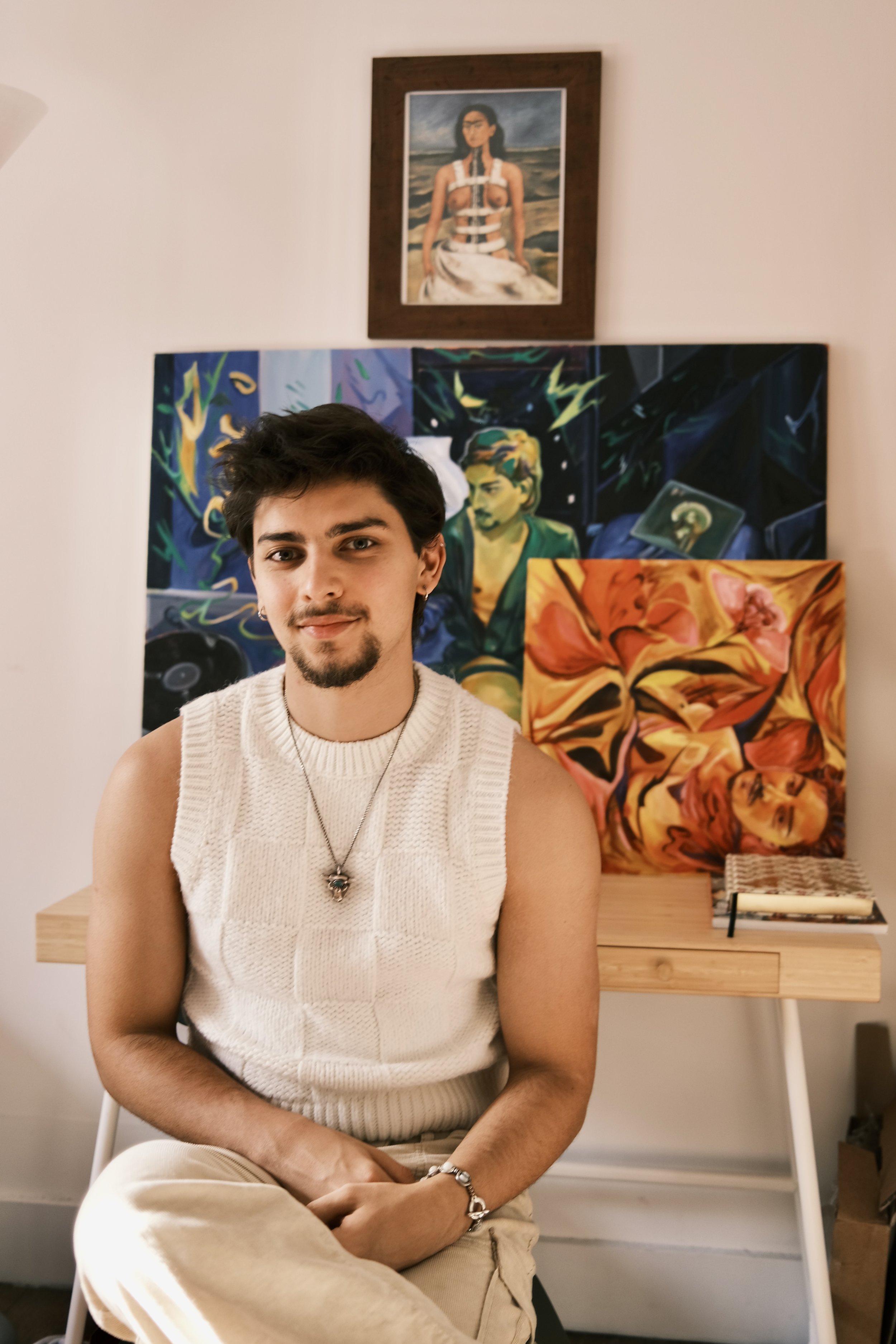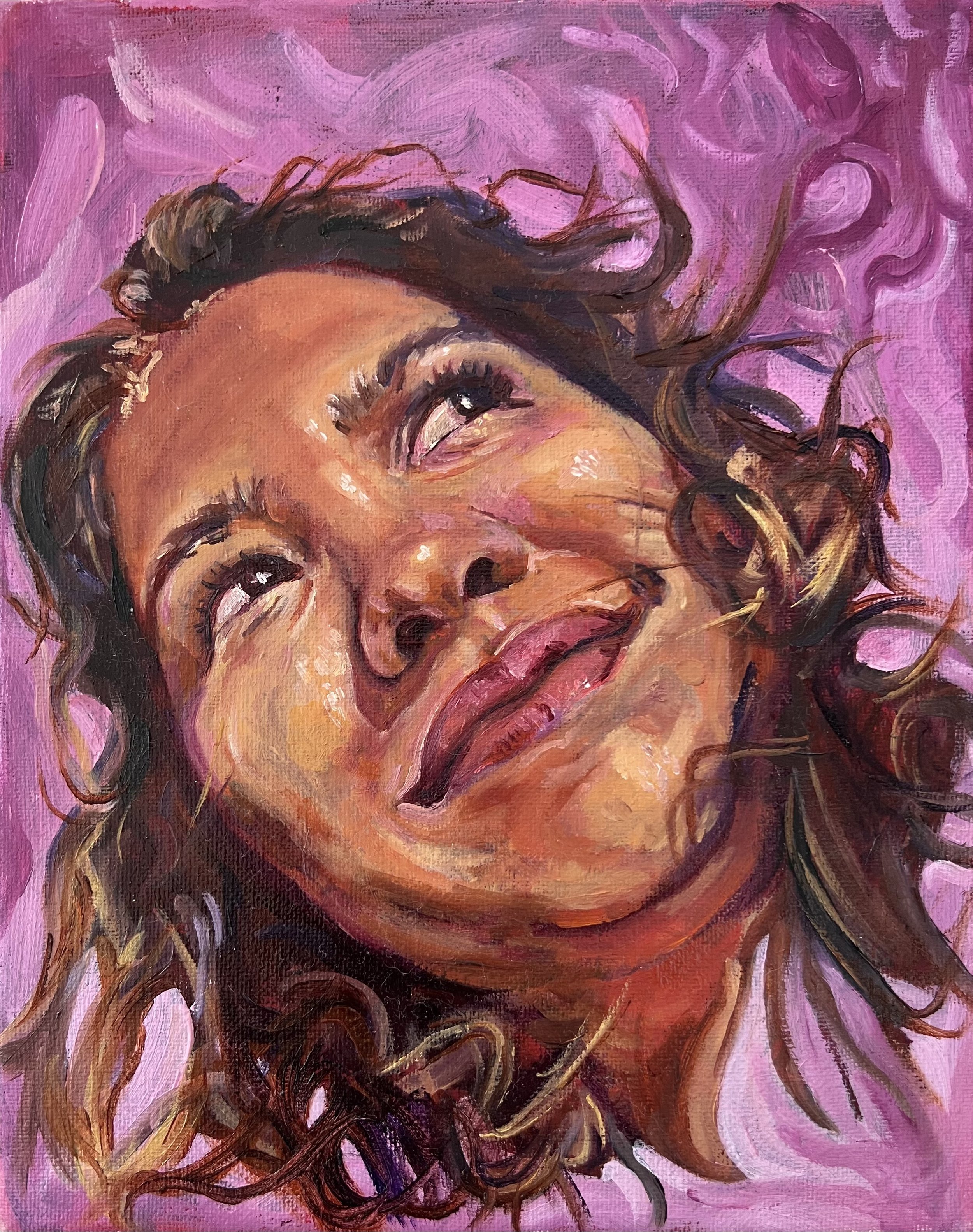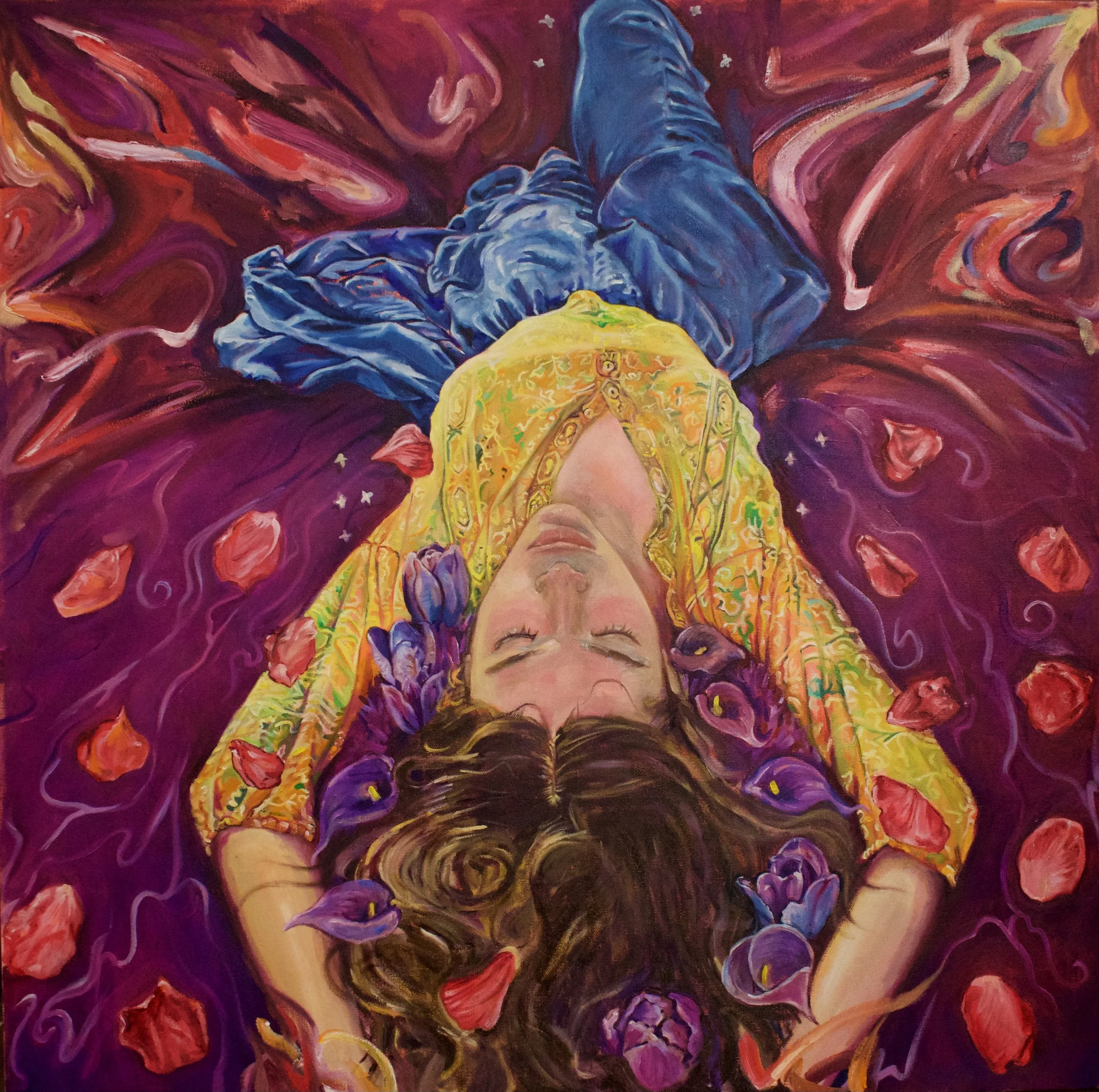Feature by Iker Veiga
Photos by Sungyoon Lim
Carlos Sánchez-Tatá is a junior studying Art History and Visual Arts at Columbia College. His work oscillates between abstraction and portraiture, and explores the tensions between queerness and his Venezuelan heritage. Through his musical, vibrant style, Carlos enchants the viewer, inviting them to take part in a moment of absolute ecstasy. We met via Zoom to discuss healing, passion, and being an artist in New York City.
Can you talk about your first memories making art?
I have always drawn and been interested in the arts. However, the first time I put thought into what I wanted to draw, I was in high school. Most of those pieces actually give me the ick today, though. My high school work was super dramatic. Back then, I used painting to explore my past trauma, so I included many references to Catholicism, which made my art very dark, and even bloody.
Hands
Did you heal through art?
It depends on what you define as healing. I try to empower myself through painting. It’s more about healing after seeing the result, rather than creating just so that I can move on. Art is one of the things that I know how to do well, therefore, in order to heal, I try to make something that I’m proud of. The process of creating is healing in itself, so I don’t often explicitly depict scenes that overwhelm me. Nevertheless, many of the topics I touch upon in my pieces do come from my own insecurities. I usually draw inspiration from themes that I’m obsessed with, that have saturated my thoughts and drained me emotionally. The charged energy of the paintings comes from my own self-awareness and restlessness. Sometimes my pieces are really sexual, sometimes they’re very busy, but there is always a tinge of anxiety to them. In order to fully capture and exploit the solitude I feel, I don’t tend to represent multiple people in one piece.
Bark
How do you explore such personal topics through portraits of other people?
At first I used to draw myself because I was the only model I had access to. I committed to self-portraiture for the longest time during high school, and my best pieces of that time are without a doubt self-portraits, but you cannot draw yourself in every work because it gets boring. As my work matured, I began to depict other people, and I soon gravitated towards queer people. It became more interesting to make these people a reflection of my consciousness. Through my models’ physicalities I am able to express narratives similar to mine in other subjects.
I believe that most of my paintings are about fifty different things, so it’s hard for me to narrow down what each of them is doing on its own. My portraits are not just representations of one person, because there are many factors in the background that complicate the situation depicted. In my work I am also trying to world-build, mainly through abstractions that seize the energy of my subjects.
North Star Aimar
Can you elaborate on the relationship between queerness and your art?
When I was in high school, I struggled to represent my identity in my art. I tried to capture what I obsessed over, but my desires always conflicted with my Catholic surroundings. Nonetheless, when I got to college, I realized that I could create art that not only represented queerness, but also celebrated it, and that is what makes my newer work more joyful. Being queer is super difficult, especially in New York City. It is super lonely and intense, but it is also colorful. The passion you feel is so rich when you are queer, especially coming from a family who are just assholes about it.
There is a particular painting, one with a drip (like my professor calls it) that my friends call a “sex painting.” As sexual as “Wild Anticipation” is, it carries a bigger meaning than that. That painting was a huge breakthrough for me at the moment because it made me confront my sexuality. It had a lot of personal narrative to it, and it represented an absolute climax. It is about passion, it is about love.
Wild Anticipation
You can see my queerness evolve through my art. A year later, I made “The Greatest Fox Hunt,” a painting of my boyfriend, and this one was not as sexual: it was about capturing passion in a different way. Even though in my work, people usually take up the roles I want them to take, it was different in this one. In this piece, the character was not someone that I could fulfill. Since he’s someone I have a relationship with, this painting is not about me: it’s about us.
The Greatest Foxhunt
How can we see your background clashing with your queer identity in your art?
I lived in Venezuela until I was 6 years old, which inherently made my upbringing a lot more colorful. Venezuelan people are a lot more artistic than they think; they are also funnier than what they think, which has really helped me. Even if someone looks at my work and thinks that they are all serious pieces, humor is the only thing that has helped me besides art itself. My surroundings were also extremely Catholic while growing up, which conflicted with my identity and with the stories I want to tell through my art.
In spite of this, I cannot ignore the influence that Catholicism has on my art. Even if my portraits don’t display it directly, there is a big religious inspiration that I drew from the images of Saints I was exposed to while growing up. In fact, one of the reasons why I am also studying art history is because of my passion for Medieval Christian art. I took a class with Gregory Bryda that I loved, where I learned about symbolism, which characterizes my work now. At first, the inspiration I drew from religion came from a place of pain, because Christianity was not the place where I wanted to be. But now that I have clawed myself out of it, even if my influences come from elsewhere, religious motifs still make it into my work.
One of my favorite artists is Naudline Cluvie Pierre. Her work is mythological, but it looks religious, and she often presents the viewers with moments of climax, which is something I do as well. I want you to witness a moment of greatness. And that is so religious!
Untitled Abstract
I am still trying to reconcile myself with Catholicism, because I can’t just be like “I hate Jesus,” and move on. I look at, for example, Ethel Cain, and I realize that she’s not only satirizing religion, but also dealing with her own religious trauma, and that is something I must do, as much as it scares me, because it underlies most of my paintings.
What techniques do you use to create these moments of greatness?
Sometimes, even when it’s good, modern art can be really fucking awful - but when it is very good, it is not boring. My technique is not perfect, but the one thing I don’t want is to bore people with my work. Basically because I don’t want to bore myself making it either. I try to use a vibrant color palette to achieve this.
For a long period of time I was obsessed with using very rich magentas and yellows, because to me they are the colors of passion. When I combined them, the intensity was unmatched; it felt like a summer garden blooming. If I think of paradise, greatness, and passion, those colors immediately come to mind. Unfortunately, I recently realized that using that palette was driving me to a block. So even though it was truly inspiring, in my recent work I have moved away from it and have started using more blues and greens.
A Morning When I Felt Beautiful
When I started painting, I didn’t plan my work out beforehand and just went for it.” You can clearly see this in “A Morning When I Felt Beautiful.” This piece was also a breakthrough in my production, because when I painted it, I didn’t know how to create an abstracted world yet. With that piece, I began to learn how to balance figure and background, which has defined my artistic persona ever since. Nevertheless, that was also sort of limiting, because in the end I was trying to represent subjects in extremely ungrounded and unrealistic worlds which was draining creatively. At some point, my works began to feel as if I was just creating an abstract background and putting a person up forefront. So recently I have been working on improving my compositions, which can be seen in my recent work.
The more serious I have become about painting, the more I have realized that I still have a lot left to learn. There is always something wrong with paintings; they are never perfect. I never feel like I have mastered my craft. Even when people appreciate my work, I don’t try to show off, but to learn. Everything I do is about exploring and listening to others.
Riley II
Has your art-making process evolved as your technique changed?
My process always starts with music. It has been the catalyst of most of my art, and I believe it is what made me become an artist. Music inspired me to first explore the creative fields, and I still listen to music to create my abstractions: the movements I make, the brush strokes in my paintings. Everything comes from music. It invites me to be more generative, and to come up with more sharp, decorative bold shapes.
Unfortunately, the process of creating requires way more planning than that. I wish I could just go into a painting and make it out of spur moment. Some great abstract works have been made like that, but with portraiture, I must start with the idea I have of a person, understand the world they are in, and what they want to say. Sometimes they are just lying down, feeling confident. But they acquire a different meaning as I implement colors and shapes. Many of my professors at Columbia have helped me understand how to implement the spontaneity of my process into a structured plan to achieve grounded, energetic pieces that enrapture my audience.
Bedroom Choir
You have mentioned how art classes have helped you grow as an artist. How is it like to be an aspiring artist both at Columbia and in the city?
I am really thankful for Columbia’s Visual Arts department. Even though it is a really small department, they do the best they can. Their classes are fabulous, and I love that I get to interact with a lot of MFA students in them. I think a lot of people who want to dive into visual arts at this school are too scared. I understand it, but it is also sad. Even though it is a really competitive field, I wish people would lean fully into their passions.
Being an artist in the city is really weird, because it makes you hopeful that you can be successful in an art career, even when people who are not in the world of the arts don’t fully understand the economics of it. But it is possible.
The advice I’ve gotten the most from other artists and professors is that I should be making more art right now, and putting it out there. But unfortunately, it is not like a STEM job, where you can find a job right after college. These jobs are riskier, and they don’t come that often. A lot of people support their art careers with a day job. So I will probably have a day job forever. This life makes you hustle a lot, and even though there are only very few opportunities coming my way, this is me. I am taking this seriously. Art is what I do professionally, and it is fucking hard sometimes. Because no one tells you how to make a name for yourself. It is something that I take really seriously and in the end is really hurtful and stressful for me.
Overall, I think that people don’t comprehend the arts as a career. I understand why, because it is hard to get money from it, and the process is not linear, but I am in too deep, and I cannot do any other career. So it is high stakes, but it is also more fun that way. I am confident in myself and my vision. I want to see my work hung in galleries and museums.
In the last few years, I have learned how to navigate and understand my own art, and everyday I see such a big improvement in my technique. I just wish there were more opportunities like Ratrock, to help people access freelance artists’ work. I hope I won’t be too broke for a while, but it is also more fun that way. You can’t be ultra successful all the time.
Unnamed
Where can the Ratrock readers find you and your art?
I have a website with my art. But my Instagram is what I am always on. So if anyone is interested in my art they can check me out @carlossancheztata. I am really pro-random people messaging me, so don’t doubt and DM me if you want to talk about art!




















